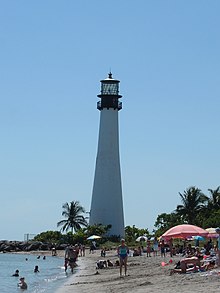Cape Florida Light

The Cape Florida Light
|
|
|
Florida
|
|
| Location | Cape Florida Key Biscayne Florida United States |
|---|---|
| Coordinates | 25°39′59.72″N 80°09′21.47″W / 25.6665889°N 80.1559639°WCoordinates: 25°39′59.72″N 80°09′21.47″W / 25.6665889°N 80.1559639°W |
| Year first constructed | 1825 (first) |
| Year first lit | 1847 (current) |
| Automated | 1978 |
| Deactivated | (1878-1978) and (1990-1996) |
| Foundation | brick on coral reef |
| Construction | brick tower |
| Tower shape | tapered cylindrical tower with balcony and lantern |
| Markings / pattern | white tower, black lantern |
| Height | 95 feet (29 m) |
| Focal height | 100 feet (30 m) |
| Original lens |
1846: 17 Argand lamps with 21-in reflectors 1855: Second-order Fresnel lens |
| Current lens | 300 mm lens (1996) |
| Characteristic | Fl W 6s. |
| Admiralty number | J2956.4 |
| ARLHS number | USA-118 |
| USCG number | 3-0923 |
| Managing agent |
State of Florida |
|
Cape Florida Lighthouse
|
|
| Location | SE tip of Key Biscayne, inside Bill Baggs Cape Florida State Park, Florida |
| Area | 1 acre (0.40 ha) |
| Built | 1825 |
| NRHP Reference # | 70000180 |
| Added to NRHP | September 29, 1970 |
State of Florida
The Cape Florida Light is a lighthouse on Cape Florida at the south end of Key Biscayne in Miami-Dade County, Florida. Constructed in 1825, it guided mariners off the Florida Reef, which starts near Key Biscayne and extends southward a few miles offshore of the Florida Keys. It was operated by staff, with interruptions, until 1878, when it was replaced by the Fowey Rocks lighthouse. The lighthouse was put back into use in 1978 by the U.S. Coast Guard to mark the Florida Channel, the deepest natural channel into Biscayne Bay. They decommissioned it in 1990.
Within the Bill Baggs Cape Florida State Park since 1966, the lighthouse was relit in 1996. It is owned and operated by the Florida Department of Environmental Protection.
The construction contract called for a 65-foot-tall (20 m) tower with walls of solid brick, five feet thick at the bottom tapering to two feet thick at the top. It was later found that the contractor had scrimped on materials and built hollow walls. The first keeper of the lighthouse was Captain John Dubose, who served for more than ten years. In 1835 a major hurricane struck the island, damaging the lighthouse and the keeper's house, and flooding the island under three feet of water.
When the Second Seminole War started in 1835, the Seminoles attacked the few European-American settlers in southern Florida. In January 1836 the Seminoles massacred the family of William Cooley at their coontie plantation on the New River, in what is now Fort Lauderdale.
...
Wikipedia

